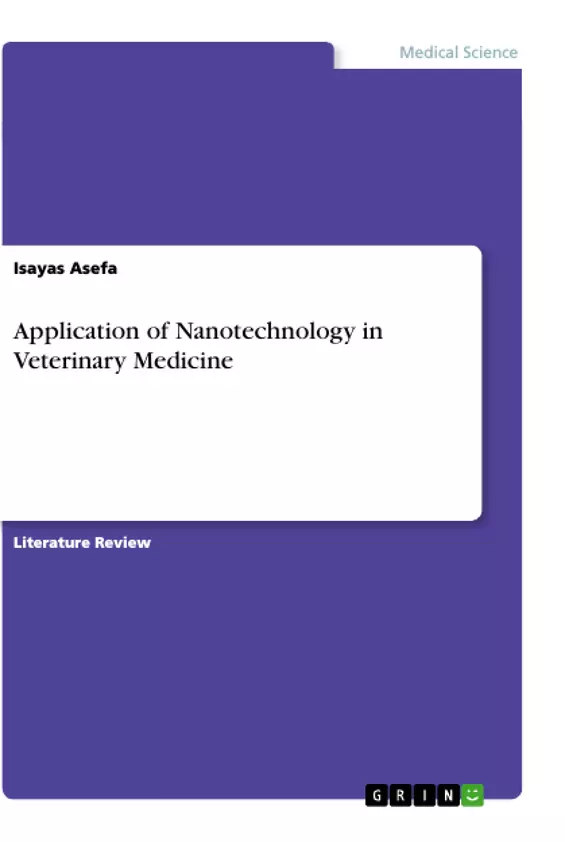The objective of this seminar paper is to review the application of nanotechnology on smart drug delivery system, in animal disease treatment and diagnosis, animal breeding and reproduction and also chicken product. Nanotechnology is an exciting and rapidly emerging technology allowing us to work at the molecular level, often atom by atom, to create and manipulate tools, materials and functional structures that have nanometer dimensions. It has the potential to have greats impact on diagnosis and treatment of animals. Unique size dependent properties of nanoparticles have numerous diagnostic applications such as diagnostic biosensors, imaging nanoprobes for magnetic resonance imaging contrast agents.
Using nanotechnology multifunctional nanomaterial’s can be designed to image a specific organ, target tissue, access deep molecular targets and provide drugs at controlled release. Great advances have been and are being made in nanobiochip materials, nanoscale biomimetic materials, nanomotors, nanocomposite materials, interface biomaterials and nanobiosensors with enormous prospect in veterinary medicine application. It is a research and development aimed at understanding and working with seeing, measuring and manipulating at the atomic, molecular and supramolecular levels. This correlates to length scales of roughly 1 to 100 nanometers. At this scale, the physical, chemical and biological properties of materials differ fundamentally and often unexpectedly integrated sensing, monitoring and controlling system could detect the presence of disease and notify the farmer and veterinarian to activate a targeted treatment delivery system.
This is possible with nanotechnology and could permit a wide range of advances in the field of agriculture, animal and veterinary sciences such as conversion of agricultural and food wastes to energy and other useful by-products through enzymatic nanobioprocessing, development in reproductive sciences, breeding managements, disease prevention and treatment in animals and public health. Applications of nanotechnology and nanoparticles in food, animal breeding and animal productivity such as in meat production, milk production are emerging rapidly. It used to create materials and change structure, enhanced quality and texture of foodstuffs at the molecular level. This technology has a major impact on production, processing, transportation, storage, traceability, safety and security of food.
Inhaltsverzeichnis (Table of Contents)
- INTRODUCTION
- DEFINITION OF NANOTECHNOLOGY
- Application of Nanotechnology in disease diagnosis
- Nano chips
- Nano sensors
- Liposomes
- Quantum dots
- Magnetic nanoparticles
- Application of Nanotechnology in drug delivery system and Treatments
- Antimicrobials Nanoparticles in veterinary medicine
- Nano vaccine and vaccine adjuvant
- Application of nanotechnology in animal breeding
- Application of nanotechnology in animal and chicken product
- CONCLUSION AND RECOMMENDATION
- REFERENCES
Zielsetzung und Themenschwerpunkte (Objectives and Key Themes)
This seminar paper aims to review the application of nanotechnology in veterinary medicine, specifically focusing on its use in smart drug delivery systems, animal disease treatment and diagnosis, animal breeding and reproduction, and chicken product development.
- The application of nanotechnology in animal health, products, and breeding
- The potential of nanotechnology to solve challenges related to animal health and food production
- The use of nanomaterials in disease diagnosis, treatment, and drug delivery
- The impact of nanotechnology on animal breeding and reproduction
- The role of nanotechnology in improving animal-derived food products
Zusammenfassung der Kapitel (Chapter Summaries)
- Introduction: This chapter introduces nanotechnology as an emerging technology with applications in veterinary medicine. It discusses the potential impact of nanotechnology on animal health, diagnosis, and treatment, highlighting the unique size-dependent properties of nanoparticles.
- Definition of Nanotechnology: This chapter provides a definition of nanotechnology, emphasizing its focus on manipulation and control of matter at the nanoscale. It presents various definitions from different organizations, including the International Organization for Standardization (IOS) and the United States Government's National Nanotechnology Initiative.
- Application of Nanotechnology in Disease Diagnosis: This chapter explores the potential of nanotechnology in developing cheaper, faster, and more precise diagnostic tools for animal diseases. It highlights the role of nanomaterials in imaging and monitoring disease, emphasizing the use of quantum dots, nano shells, and carbon nanotubes for targeted diagnosis.
- Nano Chips: This sub-chapter discusses the application of nanochips in disease diagnosis, emphasizing their use in gene recognition, drug delivery, and monitoring bodily functions.
- Nano Sensors: This sub-chapter highlights the use of nanosensors for detecting chemical contaminants, viruses, and bacteria in agriculture and food systems, contributing to improved feedstock quality.
- Liposomes: This sub-chapter explores the use of liposomes as carriers for drug delivery and diagnostic agents. It discusses their potential applications in cancer treatment, blood pool imaging, and lymphatic imaging.
- Quantum Dots: This sub-chapter highlights the unique properties of quantum dots, such as their high photostability, tunable optical properties, and size-tunable emission. It discusses their use as fluorescent probes for biomolecular and cellular imaging, offering advantages over traditional imaging methods.
- Magnetic Nanoparticles: This sub-chapter focuses on the application of magnetic nanoparticles in diagnostic and therapeutic settings. It highlights their advantageous properties, including their ability to be controlled by external magnetic fields and their small size, enabling them to circulate through capillary systems.
Schlüsselwörter (Keywords)
Key terms and concepts related to this work include nanomaterials, nanotechnology, veterinary medicine, animal health, disease diagnosis, treatment, drug delivery, animal breeding, reproduction, chicken products, smart drug delivery systems, and imaging techniques.
- Quote paper
- Isayas Asefa (Author), 2022, Application of Nanotechnology in Veterinary Medicine, Munich, GRIN Verlag, https://www.grin.com/document/1194974



